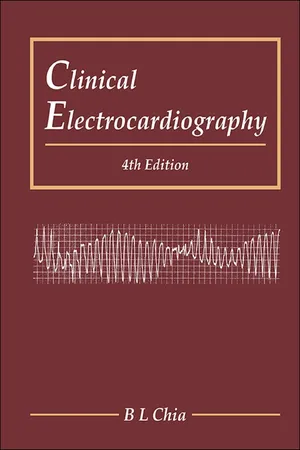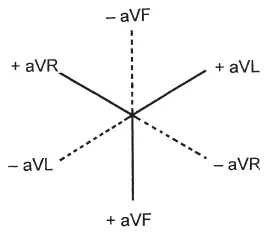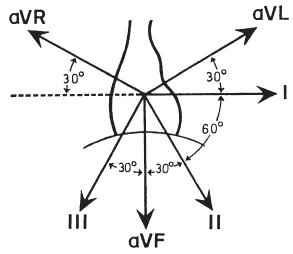![]()
CHAPTER 1
THE NORMAL ELECTROCARDIOGRAM
Fig. 1.1Electrodes are attached to the body surface to record an ECG. The right leg electrode functions solely as a ground to prevent alternating current interference and is a non-recording electrode. (Abbreviations: RA = right arm, LA = left arm, RL = right leg, LL = left leg).
An electrocardiogram or ECG is the recording of the electrical activity generated by the cells of the heart which reaches the surface of the body. This is achieved by attaching electrodes which are simply disposable paste-on disks or metal plates used to detect the electrical currents of the heart. These electrodes are placed on (1) the limbs – the right and left arms (both above the wrist) and the right and left legs (both above the ankles) and (2) at specific points on the anterior chest wall. All these electrodes are connected to the ECG recording machine via electrical wires. The electrode which is attached to the right leg functions solely as a ground to prevent alternating current interference (Fig. 1.1) and is therefore a non-recording electrode.
Fig. 1.2Diagram showing the positions of the electrode when recording the different left and right-sided chest leads.
1 to 6 = leads V1 to V6.
MCL = mid-clavicular line,
AAL = anterior axillary line,
MAL = mid-axillary line,
V3R and V4R = right-sided chest leads. See text.
From the 3 recording limb electrodes and the 6 recording chest electrodes, the following 12-lead ECG is obtained.
The 12-LEAD ELECTROCARDIOGRAM
The 12-lead electrocardiogram (ECG) consists of the following leads
(1) Six Limb (Extremity) Leads
The six limb leads (which are all in the frontal plane) consist of 3 bipolar leads – lead I (between the right and left arm), lead II (between the right arm and the left leg), lead III (between the left arm and the left leg), and 3 augmented unipolar leads – leads aVR (right arm), aVL (left arm) and aVF (left leg) (a = augmented).
(2) Six Unipolar Chest Leads
These are designated as V leads. There are six V leads (from V1 to V6) depending on where the electrode is placed on the chest (Fig. 1.2). Lead V1 is recorded with the electrode on the fourth intercostal space just to the right of the sternum, and lead V2 on the fourth intercostal space just to the left of the sternum. Lead V3 is recorded at a position exactly mid-way between leads V2 and V4. Lead V4 is recorded on the fifth left intercostal space in the mid-clavicular line. Leads V5 and V6 are recorded at the same horizontal level as lead V4, with lead V5 in the left anterior axillary line and lead V6 in the left mid-axillary line.
Apart from the above conventional 12 leads, other leads such as right-sided chest leads V3R, V4R, V5R and V6R are recorded in positions which correspond to leads V3, V4, V5 and V6 respectively, except that the electrodes are now placed on the right side of the chest instead of on the left. These leads (especially lead V4R) are particularly useful for the diagnosis of right ventricular infarction.
Recently, leads V7, V8 and V9 have been reported to be valuable in the diagnosis of posterior myocardial infarction. These 3 leads are recorded at the same horizontal level as lead V6, with the electrode being placed in the left posterior axilliary line for lead V7, left mid-scapular line for lead V8 and at the left border of the spine for lead V9. Although useful, they have not proven to be popular and are not done frequently.
CALCULATION OF HEART RATE
There are 2 methods of calculating the heart rate: (1) Box Counting Method (2) QRS Counting Method.
Box Counting Method
The ECG is normally recorded at a speed of 25 mm/sec. The horizontal distance between 1 large box on the ECG paper recorded at this speed represents 0.20 sec. Since this distance spans the length of 5 small boxes, each small box therefore represents 0.04 sec.
A simple way to calculate the heart rate is to divide 300 by the number of large boxes between 2 consecutive beats if the rhythm is regular. For example, the following are the heart rates corresponding to the number of large boxes in between 2 consecutive beats.
| Heart Rate | Number of Large Boxes between 2 Consecutive Beats |
| 300 | 1 (300/1) |
| 150 | 2 (300/2) |
| 100 | 3 (300/3) |
| 75 | 4 (300/4) |
| 60 | 5 (300/5) |
| 50 | 6 (300/6) |
| 43 | 7 (300/7) |
| 38 | 8 (300/8) |
The rationale for the above calculation is as follows. There are 300 fifths of a second in 1 minute (5 × 60). One fifth of a second (i.e. 0.20 sec) is represented by 1 large box. Therefore, the heart rate is conveniently calculated by dividing 300 by the number of large boxes between 2 consecutive beats. The Box Counting Method is accurate when the rhythm is regular, but inaccurate when it is irregular.
QRS Counting Method
This method for counting an average heart rate is accurate when the rhythm is regular or irregular (e.g. atrial fibrillation). At the normal recording speed of 25 mm/sec, the recording time of most 12-lead ECG recordings is 10 seconds (Fig. 1.3). Simply counting the number of QRS complexes within this 10 second interval and multiplying it by 6 will give you the average heart rate in beats/min.
Fig. 1.3Calculation of heart rate by QRS counting method. The number of QRS complexes in 10 sec is 13. Therefore the heart rate is 13 × 6 = 78 beats per minute. Using the Box counting method – the number of large boxes between 2 consecutive beats is 4. Therefore the heart rate is 300 ÷ 4 = 75 beats per minute. The extreme left shows ECG calibration − 1 millivolt signal = 10 mm vertical amplitude (see text).
Calculating QRS Axis
The QRS axis is defined as the mean QRS vector in the frontal plane. It is determined using the hexaxial reference system which is described below.
The Einthoven’s equilateral triangle is formed by leads I, II and III (Fig. 1.4). A triaxial reference system is obtained by redrawing the Einthoven’s triangle so that leads I, II and III intersect at a common central point (Fig. 1.4). This is done simply by sliding lead I downwards, lead II to the right and lead III to the left.
Fig. 1.4(Left hand panel) Einthoven’s equilateral triangle. (Right hand panel) Converting Einthoven’s equilateral triangle to a triaxial reference system. (Abbreviations: RA = right arm, LA = left arm, LL = left leg, Ld I = lead I, Ld II = lead II, Ld III = lead III) (see text).
A similar triaxial reference system can be obtained, this time by using the 3 augmented unipolar leads aVR, aVL and aVF (Fig. 1.5). Finally, the 2 triaxial reference systems can be combined to obtain the hexaxial reference system that shows the relationship of all the 6 limb leads (Figs. 1.6 and 1.7).
Fig. 1.5Triaxial reference system obtained from leads aVR, aVL and aVF (see text).
Fig. 1.6Hexaxial reference system obtained from the previous 2 triaxial reference systems (see text).
Fig. 1.7Hexaxial reference system diagram that is used clinically.
When calculating the axis of the heart, it is useful to assess all the limb leads (i.e....







